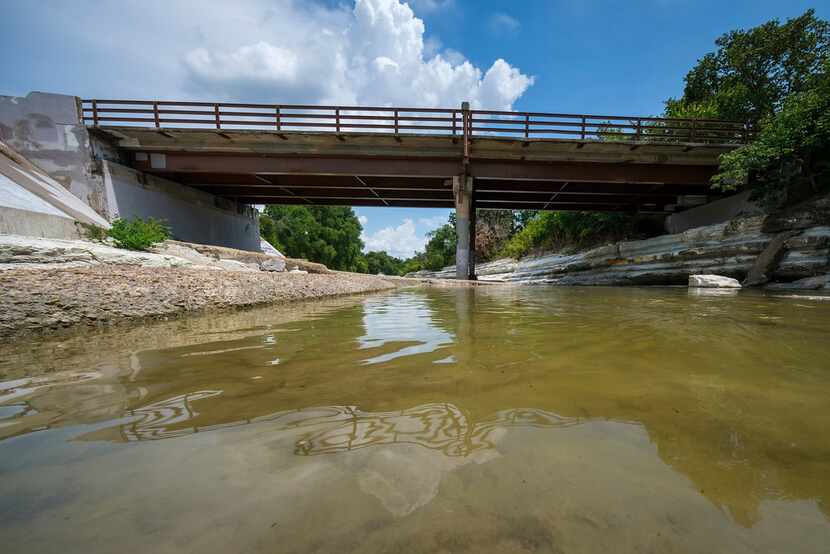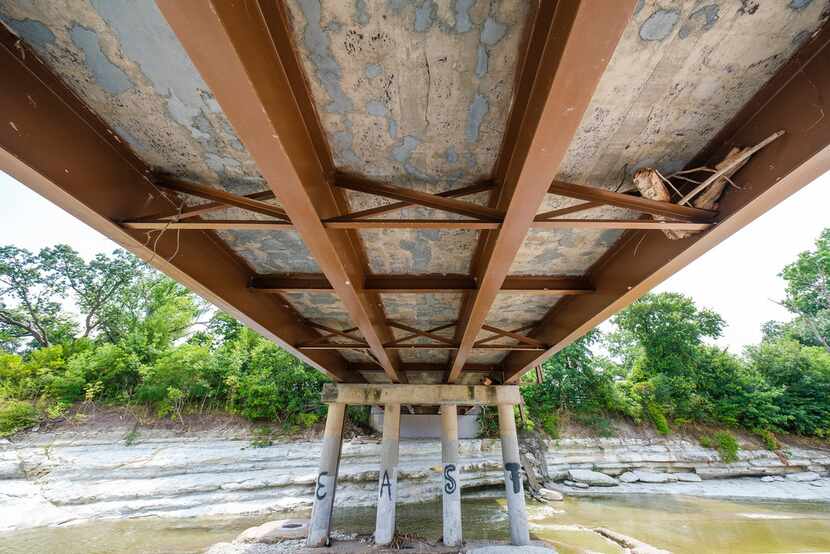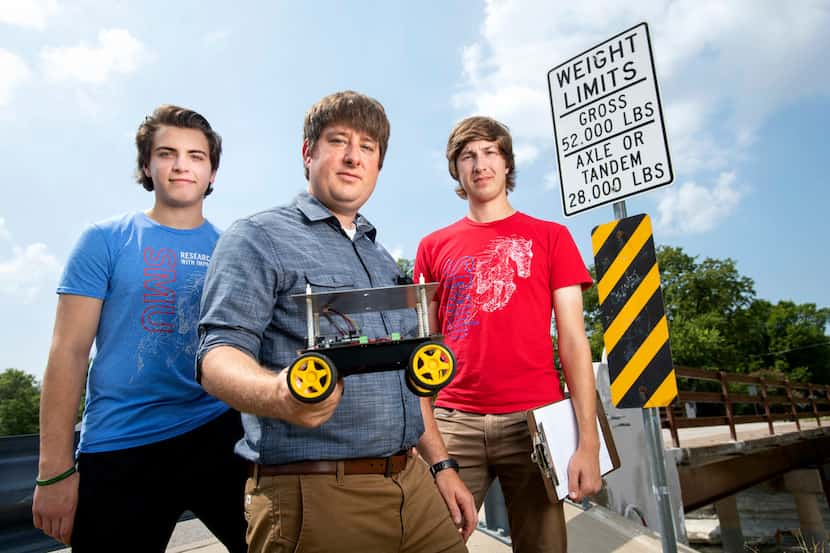Michael Polocek doesn’t think there’s a bridge that’s been talked about more — at least locally. The city of Garland’s director of engineering is referring to one of the city’s oldest — the Briarwood bridge — built in 1954 as a path across Duck Creek.
Conversation about the bridge “pops up about every two or three years,” he says. Often, the discussion centers around light maintenance: The bridge needs to be repainted or there’s debris that the periodically flooding creek left on the bridge.
SMU professor Brett Story has brought the Briarwood bridge into the limelight again. For the past few years, Story has worked with students at Garland High School to use the bridge as a test bed for a new way to continuously monitor bridges. By gathering information collected by smartphones in passing cars, Story and the students aim to check the bridge’s structural health.

Story is in search of cracks and uneven settling in the foundation that could lead to serious damage over time.
While he doesn’t think this approach could replace regular bridge inspection, it could certainly make it more efficient and safer. Bridges are often only inspected every couple years, Story says — every six months if inspectors are worried about them.
These inspections often require the entire bridge to be closed. If crowdsourcing information from smartphones can prove effective, bridges could be monitored essentially all the time — without shutting down traffic.
The information Story needs is collected by the smartphone’s accelerometer. An accelerometer is generally used to measure how quickly something is moving. Its inclusion in smartphones is to help determine the phone’s orientation. Smartphone sensors are sensitive enough, though, that they can also sense a bridge’s vibrations as we drive over it.
How does knowing the way a bridge vibrates tell you anything about whether it might need repairs? To explain the connection, Story compares a bridge to a champagne glass. When you tap the glass, “it dings very nicely and clearly,” he says. “That ding is the natural frequency at which the glass vibrates.”
But imagine that glass gets a crack in it. “When you thump that, you get a kind of a thud,” he says. “It changes the frequency. If you have damage to the structure, it may weaken the structure, so it vibrates at a different frequency.”
The ultimate goal in this line of research is to gather insight from thousands of people’s smartphones as they drive over bridges across North America.
Story is not the only scientist aspiring to crowdsource smartphone data for this purpose, though he’s one of only a few. Professor Mustafa Gül at the University of Alberta is another. “This concept has been around a couple years now. Now we are making it reality,” Gül says.
Gül and his research team have already demonstrated the potential of using smartphones to glean some insight about bridges — even when the phones are resting in a car, which has its own vibrations that need to be accounted for.
He published these findings last year in the journal Structural Health Monitoring. His research so far has been limited to people in his lab gathering data from their smartphones as they drive over bridges — mostly in Edmonton, where the University of Alberta is located.
But they, of course, aspire to expand this to anyone willing to share their smartphone data for smart bridge monitoring as they travel. To do so, “it will take many groups to work on different aspects of this to make it a real technology,” Gül says. “Dr. Story investigates a different aspect that we haven’t. We investigated different aspects that Dr. Story didn’t.”
In Story’s collaboration with the Garland high school students and support from the city of Garland, he knew that the Briarwood bridge would be a great bridge to serve as his first real-life experiment.
Almost all of Garland’s bridges are basically made of concrete. The Briarwood bridge is made of much more steel than the others, making it more flexible and bouncy. “If you’re standing on the sidewalk on that bridge and a vehicle passes over, you can feel that vibration yourself,” Story says.
But if the old Briarwood bridge is not like the other bridges in Garland, why focus on it? “When we’re initially developing, we want to work on a structure that is easy to work with,” Story says.
Teasing apart the vibrations of the vehicles from the vibrations of the bridge is quite the challenge — and each vehicle is different.
Though Story is confident that the concrete bridges won’t require a fundamentally different approach, the more subtle vibrations in those bridges will be much more challenging to separate from the bouncing of the vehicle. “If you’re learning how to snow ski, you don’t go down a triple black diamond first,” he says.
The bridge is also a bit safer for experimenting. While the aspiration is to simply assess a bridge by driving over it, Story’s research team must interact with the bridge more intimately along the way.
Most notably, they must place smartphones directly on the bridge, both on top of the bridge and on its underside. This is so they can measure the vibration of the bridge directly — without the smartphone being jostled around by the bouncing vehicle. This is crucial if they want to eventually apply their technique to bridges on highways or Interstates where it’s not so easy to waltz onto it and set down a phone.

With Story’s work contributing to the effort, Gül believes that “by the end of next decade, such technologies — not just this one — but many similar technologies will be used: crowdsourcing and smart infrastructure systems.”
And once again, the much-discussed, historic Briarwood bridge finds itself in a topic of conversation — this time, contributing to understanding how to develop a smart bridge monitoring system.
“Even if we’re a small part of it,” Garland’s Polocek says, “I appreciate the fact that we can help out.”
Jordan Wilkerson reported on science for The Dallas Morning News as part of a fellowship with the American Association for the Advancement of Science.


/cloudfront-us-east-1.images.arcpublishing.com/dmn/QHEWKAHAJRFV5HS3KLMMS4V3L4.jpg)
/cloudfront-us-east-1.images.arcpublishing.com/dmn/X7VL7H643RAWNA62GK37UEK4TU.jpg)
/cloudfront-us-east-1.images.arcpublishing.com/dmn/TZEIU7FEABEABK3VCJGK374TJI.jpg)
/cloudfront-us-east-1.images.arcpublishing.com/dmn/6XHZI6MSPRKM7DQB7SMNIGAI6Q.jpg)
/cloudfront-us-east-1.images.arcpublishing.com/dmn/FAG2HZD4475SCY5IIQYDG4UXWU.jpg)